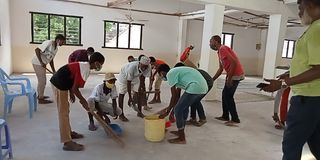Premium
Museums agency seeks Sh50m to restore two historical mosques in Lamu

Lamu's Pwani Friday Mosque, one of the oldest mosque in the country. National Museums of Kenya has raised concern over the dilapidated nature of the mosque.
The National Museums of Kenya (NMK) needs at least Sh50 million to undertake an urgent restoration of two key ancient mosques, which are under threat of extinction.
The two, Pwani and Siyu, are important icons of Lamu as a World Heritage site, having existed in the area for between 300 and 700 years.
The two mosques have been gazetted as national monuments but are still in use.
Speaking when he led a group of NMK officials and the local community in undertaking general cleaning of the Pwani Mosque within Lamu Island to mark International Day for Monuments and Sites on Sunday, NMK Curator in charge of Lamu Museums and World Heritage site, Mohamed Mwenje said Lamu has more than 10 historical mosques most of which are within the archaeological sites.
Mr Mwenje stressed the need for the mosques, especially the few ones that are still standing, to be preserved.
He said the few old but standing mosques such as Pwani in Lamu Island, Siyu Friday Mosque in Pate Island and the Shella Jamia Mosque in Shella Island are managed by the local communities, which are incapacitated to undertake restoration as it is an expensive affair.

Children undertaking cleanliness of Pwani Mosque during the marking of International Day for Monuments and Site on Sunday April 18, 2021.
Siyu mosque can host more than 600 worshipers while Pwani mosque can hold up to 500 faithful in one prayer session.
Mr Mwenje reiterated that NMK was working with the local communities to reach out to development partners, conservation enthusiasts and well-wishers to seek support for the restoration of the concerned monuments.
“In Lamu, we are blessed to have old mosques such as Pwani in Lamu Town, Siyu Friday Mosque in Pate and Shella Jamia Mosque. They are still in use today and are managed by the community. These mosques, particularly Siyu and Pwani are in dilapidated state and require at least Sh50 million for their complete restoration,” said Mr Mwenje.
Imam Abdullah Swaleh Abdulrahman of the Pwani Mosque assured NMK and other well-wishers and the government of full cooperation in ensuring old mosques and other abandoned sites in Lamu are revived and preserved.
“Pwani mosque has over 700 years and needs urgent restoration. As the leader of this mosque, I welcome the move by NMK and any other willing enthusiast to come in and help us in the maintenance,” said Mr Abdulrahman.
Apart from Pwani mosque, Shella’s Jamia mosque and Siyu’s Friday mosque, Lamu has other historical mosques.
They include Takwa Friday mosque, Shanga ruined mosque, Pate’s Mwenye Kombo mosque, Ishakani ruined mosque, Manda ruined mosque, Ungwana mosque and Shalafatani Mosque in Faza.
All the mentioned mosques are overseen by NMK as part of the sites and monuments in the county.
Lamu is considered a region with the highest number of historical monuments and buildings compared to the rest of the 47 counties.
Lamu Old Town for instance remains a key tourist attraction site in the Coast region due to its effortlessly preserved culture and heritage spanning decades.
Today, the town stands as the oldest surviving town in East Africa with over 700 years of continuous human habitation.





